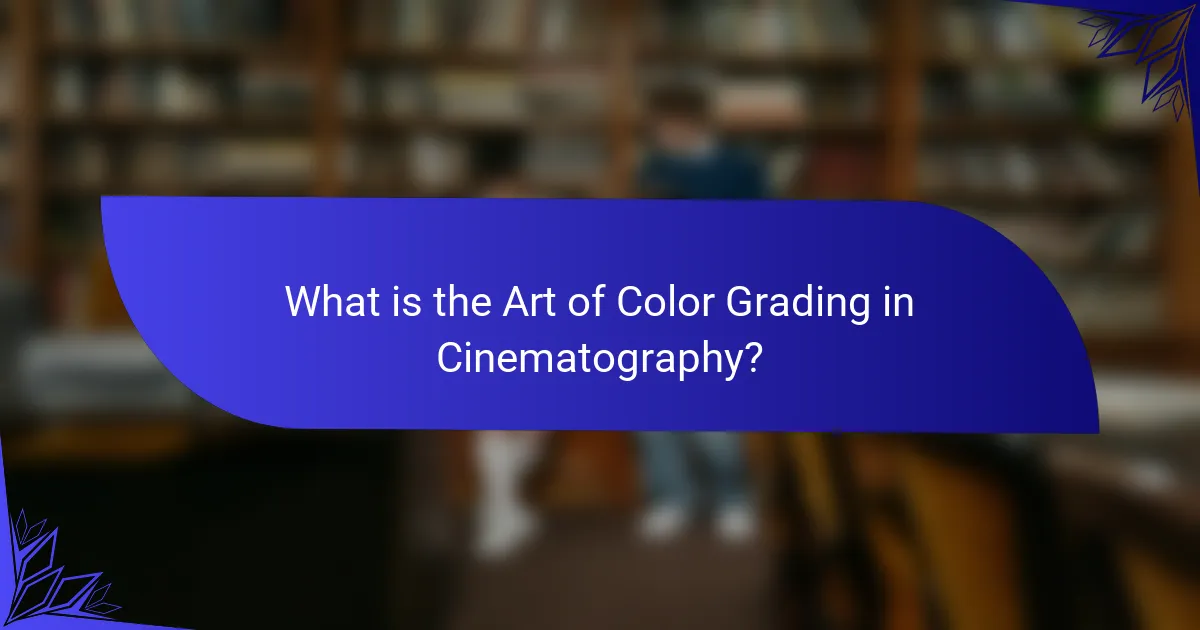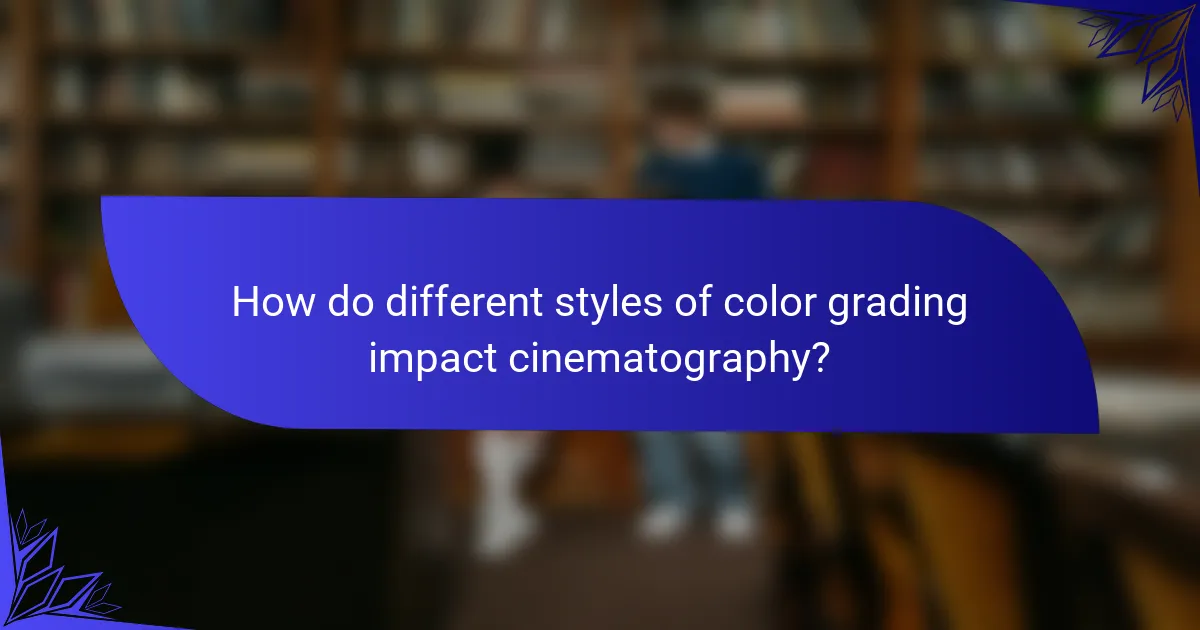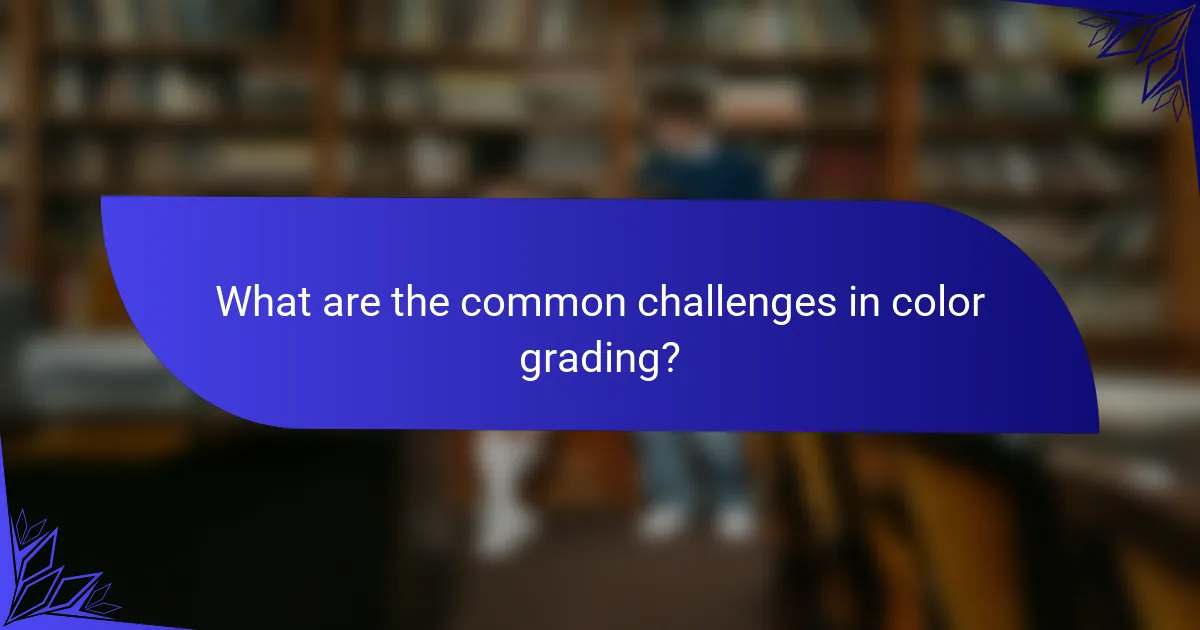Color grading in cinematography is a crucial process that enhances and alters the color of film or video to establish specific moods and atmospheres. This technique involves adjusting parameters such as contrast, brightness, and saturation, significantly impacting visual storytelling and audience emotional responses. Commonly used software for color grading includes DaVinci Resolve and Adobe Premiere Pro. The article explores various color grading styles, their emotional effects, common challenges faced during the process, and the importance of understanding color theory to achieve consistent and impactful results in filmmaking.

What is the Art of Color Grading in Cinematography?
The art of color grading in cinematography is the process of enhancing and altering the color of a film or video. This technique is used to create a specific mood or atmosphere. Color grading involves adjusting parameters such as contrast, brightness, and saturation. It can impact the emotional response of viewers. Color grading is often performed using specialized software. Programs like DaVinci Resolve and Adobe Premiere Pro are commonly used. The process can significantly change the visual storytelling of a project. Many filmmakers consider color grading essential for achieving a polished final product.
How does color grading influence the overall visual storytelling?
Color grading significantly influences overall visual storytelling by enhancing mood and emotional impact. It alters the color palette to evoke specific feelings. For example, warmer tones can create a sense of comfort or nostalgia. Conversely, cooler tones might convey tension or sadness. Color grading also helps to establish time and place in a narrative. Different color schemes can indicate various time periods or locations. Additionally, it can guide the audience’s focus by highlighting key elements. This technique can draw attention to characters or important objects within a scene. Research shows that color affects viewer perception and engagement. A study by the University of California found that color can influence emotional responses in film. Thus, effective color grading is essential for compelling visual storytelling.
What are the fundamental principles of color theory in cinematography?
The fundamental principles of color theory in cinematography include hue, saturation, and brightness. Hue refers to the color itself, such as red or blue. Saturation describes the intensity or purity of a color. Brightness indicates how light or dark a color appears. These elements work together to create mood and influence audience perception. Color harmony is also essential; it involves using complementary or analogous colors for visual balance. Additionally, the emotional impact of colors can significantly affect storytelling. For instance, warm colors often evoke feelings of warmth or excitement. In contrast, cool colors can create a sense of calm or sadness. Understanding these principles allows cinematographers to enhance visual storytelling effectively.
How do color palettes affect audience perception and emotion?
Color palettes significantly influence audience perception and emotion. Different colors evoke distinct feelings and associations. For instance, blue often conveys calmness and trust, while red can evoke excitement or urgency. Research by Eisner and others shows that colors can impact mood and decision-making. In marketing, brands use specific color schemes to create desired emotional responses. For example, fast-food chains frequently use red and yellow to stimulate appetite and attract attention. The emotional impact of color is also evident in films, where color grading shapes the viewer’s experience. Studies indicate that effective color use can enhance storytelling and character development. Thus, color palettes are essential tools in shaping audience reactions and emotions.
What are the key techniques used in color grading?
Key techniques used in color grading include color correction, color matching, and color enhancement. Color correction adjusts the footage to achieve accurate colors and balance exposure. This process often involves adjusting brightness, contrast, and saturation. Color matching ensures consistency across different shots in a scene. This technique aligns colors to maintain visual coherence. Color enhancement focuses on emphasizing specific colors to evoke emotions or highlight elements. Additional techniques include the use of LUTs (Look-Up Tables) for predefined color grades and secondary color correction for targeted adjustments. These techniques collectively enhance the visual storytelling in cinematography.
How do primary and secondary color corrections differ?
Primary color corrections adjust overall image color balance and exposure. They focus on correcting the main color elements in the footage. This includes adjusting brightness, contrast, and color temperature. Primary corrections affect the entire image uniformly.
Secondary color corrections target specific colors or areas within the image. They allow for more precise adjustments without altering the entire image. This technique is useful for enhancing skin tones or isolating specific colors. Secondary corrections enhance visual storytelling by emphasizing particular elements.
In summary, primary corrections address the overall image, while secondary corrections refine specific areas or colors.
What role does color grading play in enhancing contrast and brightness?
Color grading significantly enhances contrast and brightness in visual media. It adjusts the color balance and luminance of an image. This process allows for deeper shadows and brighter highlights. Enhanced contrast makes images more visually striking. Brightness adjustments can improve visibility in darker scenes. Color grading also helps in achieving a specific mood or tone. By manipulating colors, filmmakers can guide viewer emotions. Studies show that well-graded images can increase audience engagement.
How can color grading be used to create specific moods or atmospheres?
Color grading can be used to create specific moods or atmospheres by adjusting hues, saturation, and contrast. Different color palettes evoke distinct emotional responses. For example, warm tones like reds and oranges can create feelings of warmth and comfort. In contrast, cooler tones like blues and greens often convey calmness or sadness.
High contrast can intensify emotions, while low contrast may create a more subdued atmosphere. Color grading also enhances storytelling by aligning visual elements with narrative themes. Studies show that color influences perception and mood, reinforcing its importance in cinematography. For instance, a 2019 study by the University of California found that color affects viewer emotions significantly.
What tools are essential for effective color grading?
Essential tools for effective color grading include professional software, hardware, and monitoring equipment. Popular software options are DaVinci Resolve, Adobe Premiere Pro, and Final Cut Pro. These programs provide advanced color correction and grading features. Hardware tools like color grading panels enhance precision and speed in adjustments. Examples include the Tangent Element and Avid Artist Color. Quality monitoring equipment, such as calibrated reference monitors, ensures accurate color representation. Accurate monitors help editors see true colors during the grading process. Together, these tools create a professional color grading workflow.
What software options are available for color grading in cinematography?
Popular software options for color grading in cinematography include DaVinci Resolve, Adobe Premiere Pro, and Avid Media Composer. DaVinci Resolve is widely regarded for its advanced color correction tools and is used in many professional film productions. Adobe Premiere Pro offers integrated color grading features and is user-friendly for editors. Avid Media Composer is known for its robust editing capabilities, with color grading tools suitable for high-end projects. Other notable mentions are Final Cut Pro X, Filmora, and Assimilate Scratch, which also provide various color grading functionalities. These software options cater to different skill levels and project requirements.
How do hardware tools, such as color grading panels, improve workflow?
Hardware tools, such as color grading panels, improve workflow by streamlining the color correction process. These panels provide tactile controls that allow for precise adjustments. Users can manipulate color parameters quickly without navigating software menus. This efficiency reduces time spent on each project. Color grading panels also enhance consistency across projects. They enable colorists to replicate settings easily. Improved workflow leads to faster project turnaround times. Studies show that using dedicated hardware can increase productivity by up to 30%.
What are the benefits of using LUTs (Look-Up Tables) in color grading?
LUTs (Look-Up Tables) enhance color grading by providing a standardized method for color correction. They allow filmmakers to achieve a consistent look across multiple shots. LUTs can save time by streamlining the grading process. They enable quick previews of color adjustments before finalizing edits. LUTs also facilitate collaboration among team members by ensuring everyone works with the same color reference. They are widely used in both film and digital media, making them versatile tools for color grading. Studies show that using LUTs can significantly improve workflow efficiency in post-production.

How do different styles of color grading impact cinematography?
Different styles of color grading significantly impact cinematography by influencing the visual tone and mood of a film. For instance, a warm color grade can evoke feelings of comfort and nostalgia. In contrast, a cooler color palette might create a sense of detachment or tension.
High-contrast grading can enhance drama and highlight emotions, while a desaturated look may convey bleakness or realism. The choice of color grading affects audience perception and engagement with the story.
Research shows that color grading can alter viewer emotions and responses. A study by the University of California found that specific color tones can trigger emotional reactions, thus affecting the storytelling experience.
What are the various styles of color grading used in film and video production?
There are several styles of color grading used in film and video production. These styles include natural, stylized, and vintage grading. Natural grading aims to enhance the image while maintaining realistic colors. Stylized grading often employs bold colors to evoke specific emotions or themes. Vintage grading mimics the look of older films, using muted tones and grain. Other styles include cinematic, which emphasizes a dramatic look, and monochromatic, which uses a single color palette. Each style serves a distinct purpose in storytelling and visual impact.
How does the choice of style affect the narrative and aesthetic of a project?
The choice of style significantly influences the narrative and aesthetic of a project. Different styles evoke distinct emotional responses. For instance, a dark, moody style can create tension and suspense. Conversely, a bright, vibrant style can convey joy and optimism.
In cinematography, color grading is a crucial stylistic choice. It alters the mood and tone of scenes. Research shows that color grading can affect viewer perception and engagement. A study by the University of California found that color choices can enhance storytelling by aligning visuals with emotional cues.
Thus, the selected style shapes not only the visual appeal but also the underlying message of the project.
What are the characteristics of popular color grading styles like Teal and Orange?
Teal and Orange is a popular color grading style characterized by a strong contrast between warm and cool tones. The style enhances skin tones by applying orange hues while simultaneously introducing teal shades to the shadows. This contrast creates a visually appealing and dynamic look. Teal and Orange is frequently used in action films and advertisements to evoke excitement and energy. The color grading style is effective in drawing attention to subjects against vibrant backgrounds. Additionally, it can create a cinematic feel, making scenes more dramatic and engaging. The technique is often employed in post-production software like Adobe Premiere and DaVinci Resolve, allowing for precise adjustments.
How does color grading differ between various genres?
Color grading differs significantly between various genres due to the emotional tone and visual storytelling required. For example, horror films often utilize desaturated colors and high contrast to create a sense of unease. In contrast, romantic comedies typically feature warm tones and vibrant colors to evoke feelings of joy and love.
Action films may employ a cooler color palette with high saturation to enhance adrenaline-fueled scenes. Documentaries often favor natural colors to maintain authenticity and realism.
Science fiction films frequently utilize bold, futuristic colors and high contrast to create otherworldly environments. Each genre’s unique color grading approach supports its narrative and emotional goals effectively.
What unique color grading techniques are used in horror films?
Horror films often use unique color grading techniques to enhance tension and evoke fear. One common technique is desaturation, which reduces color intensity to create a bleak atmosphere. Another technique is the use of cool color palettes, such as blues and greens, to evoke feelings of unease. High contrast is also prevalent, emphasizing shadows and creating a sense of dread. Some horror films employ color shifts, like a green tint, to suggest decay or otherworldliness. Additionally, selective color grading can highlight specific elements, like blood, to amplify horror. These techniques are supported by studies indicating their effectiveness in influencing viewer emotions.
How does color grading contribute to the visual identity of documentaries?
Color grading significantly shapes the visual identity of documentaries. It enhances storytelling by establishing mood and tone. Different color palettes evoke specific emotions. For instance, warm tones can create a sense of nostalgia, while cooler tones might convey sadness or detachment. Color grading also provides consistency across various scenes. This uniformity helps audiences connect with the content cohesively. Additionally, it can highlight important elements within the frame. By guiding the viewer’s eye, color grading emphasizes key subjects or themes. Overall, effective color grading transforms raw footage into a visually compelling narrative.

What are the common challenges in color grading?
Common challenges in color grading include achieving consistent color across shots. Variations in lighting and camera settings can cause discrepancies. Balancing skin tones is often difficult, especially in mixed lighting conditions. Maintaining detail in highlights and shadows is another challenge. Color grading software can be complex, requiring technical skills. Limited dynamic range in footage can restrict grading options. Understanding color theory is essential to avoid unintentional color casts. Finally, time constraints can pressure colorists to rush the grading process, impacting quality.
What issues might arise during the color grading process?
Issues during the color grading process include color mismatches, inconsistent lighting, and technical limitations. Color mismatches can occur when different cameras capture footage with varying color profiles. Inconsistent lighting can lead to discrepancies in color balance across scenes. Technical limitations may arise from software compatibility or hardware performance issues. Additionally, color grading can be affected by monitor calibration, leading to inaccurate color representation. Human error, such as incorrect adjustments, can also impact the final output. These issues can compromise the overall visual quality of the project.
How can lighting inconsistencies affect color grading outcomes?
Lighting inconsistencies can significantly disrupt color grading outcomes. Variations in light intensity and color temperature can lead to uneven color representation. Different lighting conditions can cause unwanted color casts in footage. These casts may not match across different scenes, complicating the grading process. Inconsistent lighting can also affect shadows and highlights, altering the perceived depth and texture of images. This variability can result in a disjointed visual narrative. Moreover, color grading software relies on consistent lighting for accurate adjustments. Without uniform lighting, achieving a cohesive look becomes challenging.
What are the best practices for color grading to avoid common pitfalls?
To avoid common pitfalls in color grading, use calibrated monitors. This ensures accurate color representation. Consistently check your work in multiple environments. This helps identify discrepancies in color perception. Maintain a balanced color palette throughout your project. This prevents overwhelming or distracting colors. Use reference images for consistency. This guides your grading decisions. Avoid over-processing footage, as it can lead to unnatural results. This keeps the final product looking authentic. Regularly save different versions of your project. This allows for easy comparisons and adjustments.
What are some tips for achieving successful color grading?
Successful color grading requires a clear understanding of color theory and the desired mood. Begin by analyzing the footage to identify its strengths and weaknesses. Use scopes like waveform and vectorscope to monitor color balance and exposure. Experiment with primary color corrections to achieve a balanced look. Apply secondary corrections to enhance specific areas or elements in the frame. Maintain consistency across shots to ensure a cohesive visual style. Use LUTs (Look-Up Tables) for creative looks while retaining control over adjustments. Finally, always review your work on calibrated monitors to ensure accuracy. These steps are essential for achieving professional results in color grading.
How can one effectively balance color grading with the original footage?
To effectively balance color grading with the original footage, one should use reference images. Reference images provide a benchmark for color accuracy. Compare the graded footage to these references during the grading process. This helps maintain consistency in color tones. Utilize scopes like waveforms and vectorscopes to analyze color distribution. Scopes reveal if colors are clipped or imbalanced. Adjust color grading based on this analysis to ensure fidelity. Regularly toggle between graded and original footage for visual comparison. This allows for immediate assessment of changes made. By following these steps, the color grading process remains aligned with the original intent of the footage.
What are the recommended workflows for efficient color grading?
The recommended workflows for efficient color grading include several key steps. First, organize your footage into a clear project structure. This helps streamline the grading process. Next, perform a preliminary color correction to balance exposure and white balance. This establishes a neutral starting point. After that, apply creative grading to enhance the visual style. Use tools like LUTs to achieve desired looks efficiently.
Additionally, utilize node-based systems for better control over adjustments. This allows for non-destructive editing and easy modifications. Finally, render and review the graded footage in various formats. This ensures consistency across different viewing platforms. Following these steps leads to a more efficient color grading workflow.
The primary entity of this article is color grading in cinematography, which involves enhancing and altering the color of film or video to evoke specific moods and atmospheres. The article covers key techniques such as color correction, color matching, and the use of Look-Up Tables (LUTs), along with essential tools like software and hardware for effective grading. It discusses the influence of color grading on visual storytelling, audience perception, and emotional responses, while also addressing common challenges and best practices in the grading process. Various styles of color grading and their impact on different genres are explored, providing a comprehensive overview of this critical aspect of cinematography.